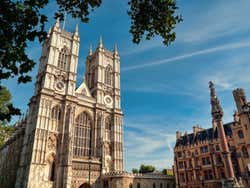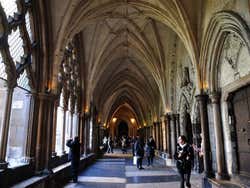
Westminster Abbey
Westminster Abbey is London’s most famous and oldest religious building, where the monarchy is crowned and the remains of the Royal Family and famous British people are buried.
A journey through time
The Romanesque abbey church was consecrated in 1065, having been a Benedictine monastery previously. Between 1245 and 1517 it was rebuilt in a gothic style, and during the eighteenth century, it suffered an important transformation with the construction of its two main towers.
Although the abbey was seized by Henry VIII during the Dissolution of the monasteries in 1539, a year later, it was granted the status of a cathedral sparing it from destruction or dissolution, a fate many churches and abbeys would suffer in England and Ireland during Henry VIII's reign. This link to the British Monarchy also safeguarded the abbey from the iconoclastic attacks in 1640.
All monarchs have been crowned in the abbey following the coronation of William the Conqueror in 1066. Since the fourteenth century, when King Edward I had an oaken chair made with the Stone of Destiny (a red sandstone used for centuries in Scottish coronations), all the kings and queens have remarkably used the same medieval throne.
Some of the latest events celebrated in Westminster Abbey include the 80th birthday of Queen Elizabeth II and Princess Diana’s funeral.
Inside Westminster Abbey
The outer walls of the abbey are some of the best examples of medieval architecture in London. With an impressive collection of tombstones and mausoleums of famous British people, the temple is an important landmark.
There are several places of interest inside the building, all conveniently explained while you do the tour with the audio guide. These are some of the most noteworthy:
- Lady Chapel: One of the most impressive chapels in the abbey, it maintains its magnificent ceiling and choir chairs since 1512.
- Poet’s Corner: This section of the abbey is called Poet’s Corner because a large number of poets and writers are buried and commemorated here.
- King Edward’s Throne: This throne, dating from the fourteenth century, is still used at every coronation, which is always led by the Archbishop of Canterbury.
- Cloisters: The beautiful cloisters built between the thirteenth and fourteenth centuries connect the building's church with the rest of the areas.
- College Garden: Over 900 years old, the College Garden is the oldest park in the UK.
Definitely worth visiting
Although the admission ticket is quite pricey, it's worth visiting to discover its impressive decoration and the architectural marvel that the abbey preserves despite the passage of time. Moreover, the audio guide that is included in the ticket will allow you to enjoy the experience even more, disclosing interesting facts about the building's history while you explore it at your own pace.
The audio guide included in the entrance fee will come in handy when discovering all the details of the abbey’s history.
If you want to visit Westminster Abbey and avoid being left without your ticket, you can buy them online on our website:



Schedule
Monday to Friday: 9.30am to 3.30pm
Saturday: 9am to 3.30pm
Sunday: closed to tourists
Price
Adults: £ 25 (US$ 32.70)
Seniors over 65 and students: £ 22 (US$ 28.78)
Children aged 6 - 17: £ 11 (US$ 14.39)
Children under 6: free entry
Free entry with the London Pass
Westminster Abbey Tickets £ 27 (US$ 35.32)
Transport
Tube: Westminster Station, Circle, District, and Jubilee lines; St James' Park, Circle and District lines
Bus: 3, 11, 12, 24, 29, 53, 70, 77, 77A, 88, 109, 148, 159, 170, and 211
Nearby places
Big Ben (307 m) Westminster Palace (315 m) St James’s Park (470 m) London Eye (725 m) Buckingham Palace (955 m)

